Ideas for the Community
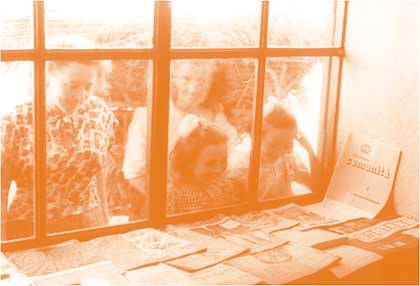
Adriano Olivetti's first steps in the field of social services were made in 1939 when the industrialist commissioned Luigi Figini and Gino Pollini to plan and construct a day nursery to be located next to the local authority-built houses in Borgo Olivetti, on a small hill opposite some workshops, on a not very large, trapezoidal-shaped plot of land. The day nursery brings to light the ongoing research of these two architects, utilizing the international architectural language of rationalism.
In 1945, Edizioni di Comunit‡ published Adriano Olivetti's book, L'ordine politico delle Comunit‡, an anthology of reflections concerning the organisation of the state made by the industrialist during the years of his internment in Switzerland. According to Olivetti, the community should be at the centre of the state organisation; a territorial unit with loose borders, culturally homogenous and economically self-sufficient. In 1948, in the wake of the book's publication, the 'Movimento Comunit‡' was founded in Turin. The organisation of the 'Movimento' was territorial: in fact, community centres would be created with the task of finding a political consensus within the community, and at the same time promoting cultural initiatives aimed at raising the standard of living of the small population centres in the Canavese area that were disturbed by the process of industrialisation. The proposals of 'Movimento Comunit‡' attracted many intellectuals from different political and cultural backgrounds and gained support in many regions of Italy.
» PDF (8,0Mb)
|
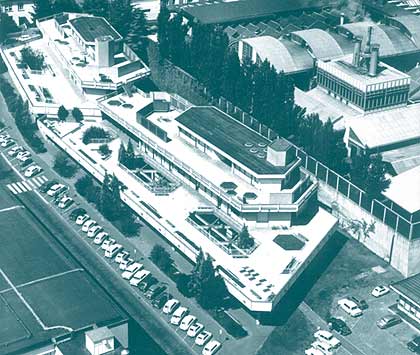
Public Facilities
In the years after WWII, all architectural planning and construction on behalf of the company became amalgamated with Movimento proposals. This bond, which ended with the death of Olivetti in 1960, would bring within the space of ten years the realisation of numerous buildings in Ivrea, including the Social Service Centre (1954-59) located opposite the Olivetti workshops, designed by Figini and Pollini, and the employee canteen (1953-59), located in the area behind the workshops, designed by Ignazio Gardella. Other noteworthy buildings in the Canton Vesco district are the nursery school (1955-63) by Mario Ridolfi and Wolfgang Frankl, and the primary school (1955-60) by Ludovico Quaroni and Adolfo De Carlo. Buildings intended for public services were also built in areas far from Ivrea and the Canavese district: as in the case of the Colonia Olivetti in Marina di Massa, an architectural project by Annibale Fiocchi and Ottavio Cascio (1948-58), and in the mountain summer camp in Brusson by Claudio Conti and Leonardo Fiori (1960-64).
» PDF (11,5Mb)
|
Territory-Industry-Housing
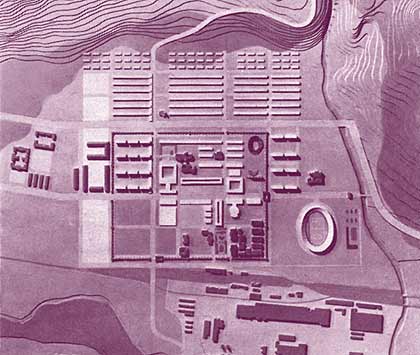
Architecture, industry and territory were the original objects of Olivetti's reflections about the relation between planning and the political, economic and social strategies of modernization.
Adriano Olivetti's interest in territorial planning evolved at the beginning of the thirties during his travels in North America and his involvement with ENIOS (Ente Nazionale per l'Organizzazione Scientifica del Lavoro - National Body for the Scientific Organisation of Work), that helped to make known production systems, the organisation of work and experiments in the USA, such as the Tennessee Valley Authority (TVA), and the Soviet Union concerning economic programming in Italy.
» PDF (9,4Mb)
|
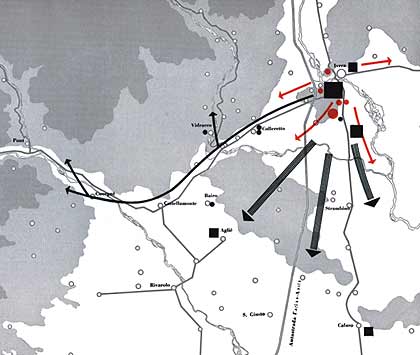
In 1934 studies were begun that later became part of the regulatory plan for Valle d'Aosta. In 1943, these works were compiled in the document Studi e proposte preliminari per il Piano Regolatore della Valle d'Aosta [Preliminary studies and proposals for the regulatory plan for Valle d'Aosta], under the direction of Olivetti and edited by Renato Zveteremich and Italo Lauro. The preliminary work of the study was based on inquiries conducted by Giovanni Trikurakis, a health official from Valle d'Aosta, who in the mid-1930s devoted himself to the study of the conditions of the local Alpine people. The plan for the Valle d'Aosta was more a collection of projects than a real town planning programme. The proposals contained in the document made clear references to the international architectural and town planning style from the 1920s and 1930s: all of the projects were based on principles of a rigid geometric disposition, regardless of the geographical location and local building practices.
» PDF (8,3Mb)
|
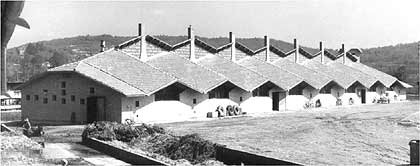
The Regulatory Plan of Ivrea
In 1937 Adriano Olivetti offered to finance a regulatory plan for Ivrea: the task was entrusted to Luigi Piccinato, Luigi Figini and Egisippo Devoti. The plan, which remained incomplete, confronted the questions of city expansion, the reorganisation of traffic systems and the renovation of the oldest and most degraded areas of the city. Studies for the regulatory plan were resumed after the war and became part of a larger, regional level picture. In 1952, the Technical Group for the Urban Coordination of Canavese (Gruppo Tecnico per il Coordinamento Urbanistico del Canavese-Gtcuc) was founded. Members of the group included Ludovico Quaroni, Nello Renacco, Annibale Fiocchi and Carlo Doglio. The idea was to produce a preliminary inquiry covering all aspects of the problems resulting from industrialisation in Ivrea and the surrounding areas. The municipal council rejected the plan in March of 1955, but after significant changes it was finally adopted in 1959.
Olivetti's Social Reform
Adriano Olivetti's initiatives in the field of town planning were not limited to the Canavese area and Ivrea. The industrialist's plans for social and political reform were also realised on a national level. This was the case with Unrra-Casas (United Nations Relief and Rehabilitation Administration-Comitato Amministrativo Soccorso ai Senzatetto) programme founded in 1946 to manage the funds of ERP (European Recovery Administration), of which Olivetti had been a member since the beginning. Among the thousands of building interventions made by Unrra-Casas, the ones supported by Olivetti are easily distinguished: in Matera, Ludovico Quaroni, Federico Gorio, Michele Valori, Piero Maria Lugli and Luigi Agati planned and constructed in 1951-54 the village of La Martella.
Ivrea and the surrounding were also locations for other initiatives associated with the name of Adriano Olivetti, as was the case of the Istituto per il Rinnovamento Urbano e Rurale [Institute for the Rural and Urban Renewal of Canavese] (I-Rur) founded in 1954. Conceived as a possible network of institutes working in many areas of Italy, I-Rur had its major development in the Canavese district, with five industrial and four agricultural schemes constructed.
The influence exercised by Adriano Olivetti on Italian town planning was such that he not only sponsored plans, projects and programmes but also challenged institutional organisations and the reformation of their operational organs. Olivetti made a decisive contribution to the rebirth of the Istituto Nazionale di Urbanistica-Inu [National Town Planning Institute]: he was nominated as a member of the national executive council in 1948 and was elected as its president in 1950.
» PDF (7,5Mb)
|
|

|
|
